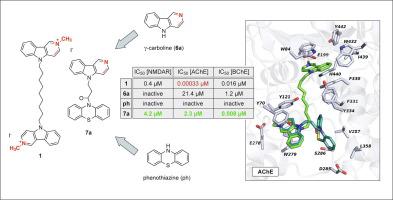Bioorganic & Medicinal Chemistry ( IF 3.3 ) Pub Date : 2021-08-08 , DOI: 10.1016/j.bmc.2021.116355 Sigrid Schwarthoff 1 , Nicolas Tischer 1 , Henrike Sager 1 , Bianca Schätz 1 , Marius M Rohrbach 1 , Ihar Raztsou 2 , Dina Robaa 3 , Friedemann Gaube 1 , Hans-Dieter Arndt 2 , Thomas Winckler 1

|
Alzheimer’s disease (AD) is the most common form of dementia. It is associated with the impairment of memory and other cognitive functions that are mainly caused by progressive defects in cholinergic and glutamatergic signaling in the central nervous system. Inhibitors of acetylcholinesterase (AChE) and ionotropic glutamate receptors of the N-methyl-d-aspartate (NMDA) receptor family are currently approved as AD therapeutics. We previously showed using a cell-based assay of NMDA receptor-mediated glutamate-induced excitotoxicity that bis-γ-carbolinium conjugates are useful NMDA receptor blockers. However, these compounds also act as subnanomolar AChE inhibitors, which may cause serious anticholinergic side effects when applied in vivo. Here, we evaluated new structures containing γ-carbolines linked to phenothiazine via a propionyl spacer. These compounds were superior to the previously characterized bis-γ-carbolinium conjugates because they blocked NMDA receptors without requiring a quaternary pyridine N-atom and inhibited AChE with moderate IC50 values of 0.54–5.3 µM. In addition, these new compounds displayed considerable selectivity for the inhibition of butyrylcholinesterase (BChE; IC50 = 0.008–0.041 µM), which may be favorable for AD treatment. Inhibitory activities towards the NMDA receptors and AChE were in the same micromolar range, which may be beneficial for equal dosing against multiple targets in AD patients.
中文翻译:

γ-咔啉-吩噻嗪偶联物同时作为 NMDA 受体阻滞剂和胆碱酯酶抑制剂的评价
阿尔茨海默病 (AD) 是最常见的痴呆症。它与主要由中枢神经系统中胆碱能和谷氨酸能信号传导的进行性缺陷引起的记忆和其他认知功能障碍有关。乙酰胆碱酯酶和的离子型谷氨酸受体的抑制剂Ñ甲基d天冬氨酸(NMDA)受体家族目前批准作为AD的治疗剂。我们之前使用基于细胞的 NMDA 受体介导的谷氨酸盐诱导的兴奋性毒性试验表明,双-γ-咔啉结合物是有用的 NMDA 受体阻滞剂。然而,这些化合物也可作为亚纳摩尔 AChE 抑制剂,在体内应用时可能会导致严重的抗胆碱能副作用. 在这里,我们评估了包含通过丙酰基间隔基连接到吩噻嗪的 γ-咔啉的新结构。这些化合物优于之前表征的双-γ-咔啉结合物,因为它们无需季吡啶N原子即可阻断 NMDA 受体,并以 0.54–5.3 µM 的中等 IC 50值抑制 AChE 。此外,这些新化合物对丁酰胆碱酯酶 (BChE;IC 50 = 0.008–0.041 µM)的抑制显示出相当大的选择性,这可能有利于 AD 治疗。对 NMDA 受体和 AChE 的抑制活性在相同的微摩尔范围内,这可能有利于 AD 患者针对多个目标的相同剂量。











































 京公网安备 11010802027423号
京公网安备 11010802027423号